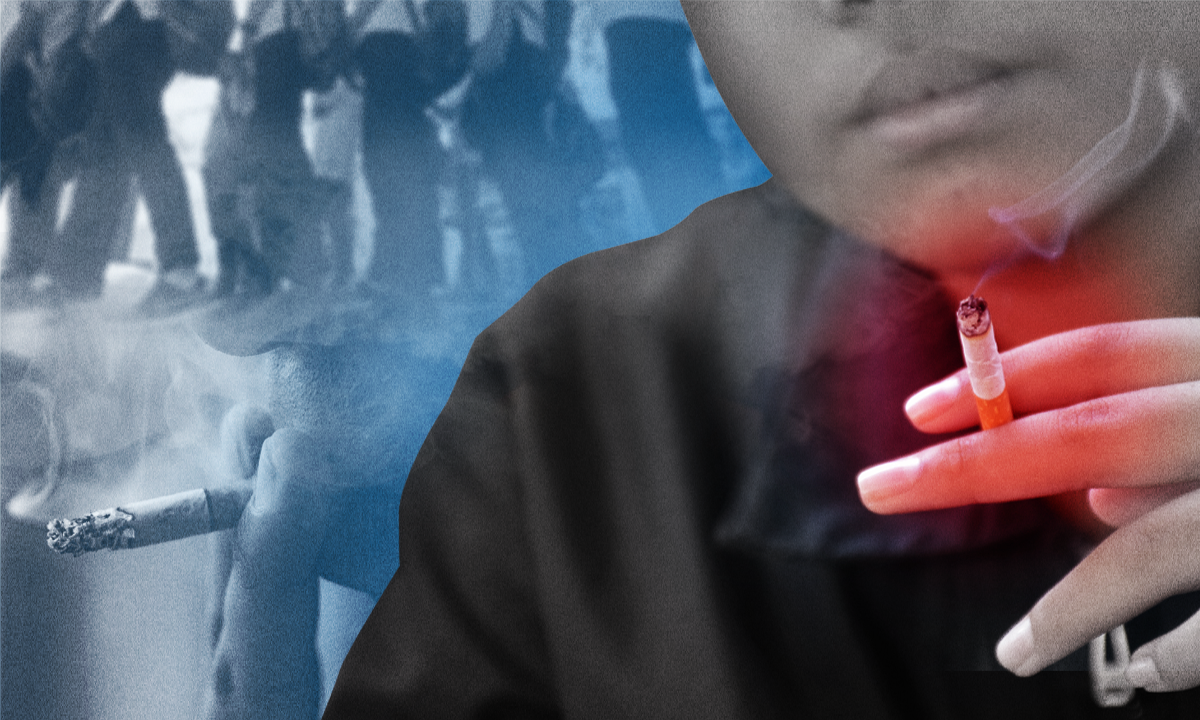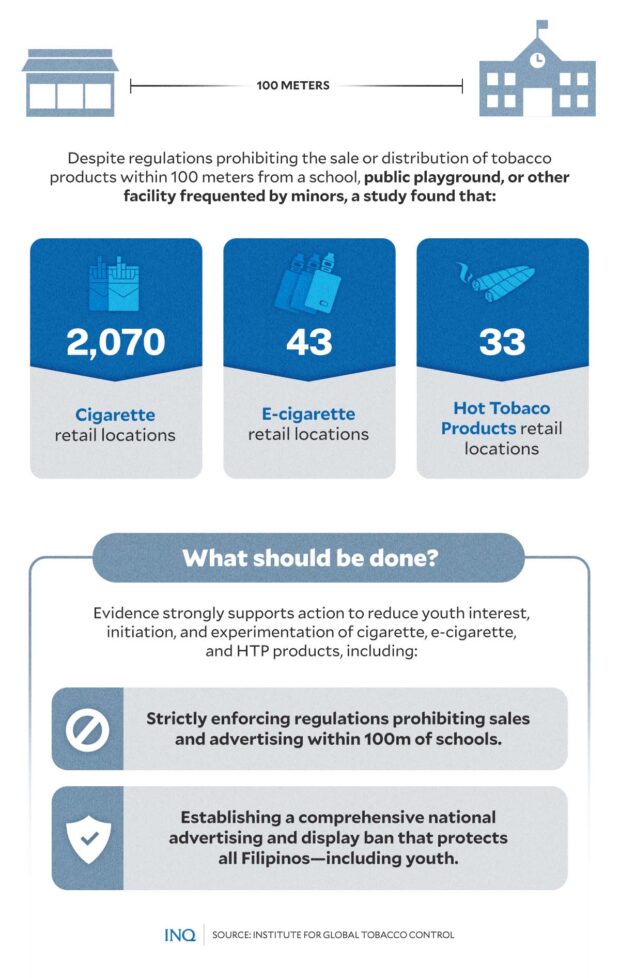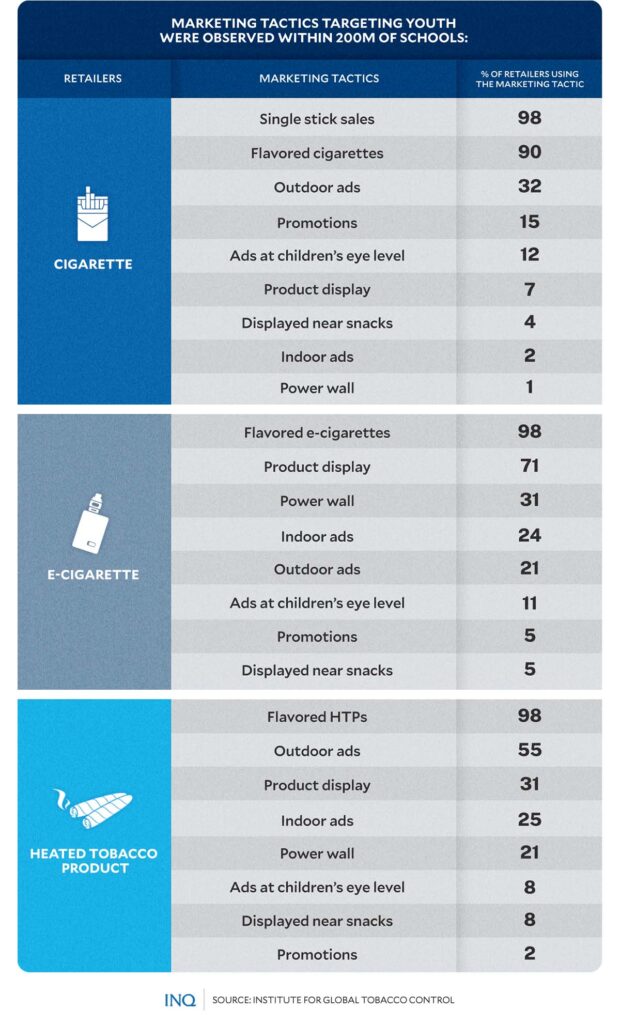As vaping ‘epidemic’ grips PH youth, tobacco sellers flout law vs targeting kids
MANILA, Philippines—Despite regulations prohibiting the sale and distribution of tobacco products near or within schools in the Philippines, a recent study found that many retailers are not complying.
To protect the youth from being initiated to cigarette smoking and tobacco use and reduce and completely ban the sale of tobacco products to minors, current regulations on e-cigarettes or vapes, and heated tobacco products (HTPs) prohibit sales, displays, advertisements, and promotions in or near schools.
The 2019 Global Youth Tobacco Survey found that around 11 percent of students in the country use tobacco, 10 percent smoke cigarettes, and 14 percent use electronic cigarettes (e-cigarettes).
Data from the Philippine Pediatric Society showed that 11 percent of students aged 10 to 15 years old have already tried vapes. The Department of Education (DepEd) also reported that 6.7 percent of Grades 7 to 9 students were found to “have tried and are using e-cigarettes.”
Among the top reasons for vape use among students were online accessibility (32 percent), flavor (22 percent), and the belief that e-cigarettes are safer than cigarettes (17 percent).
Article continues after this advertisementBoth Republic Act No. 9211—Tobacco Regulation Act of 2003—and Executive Order No. 106 by former President Rodrigo Duterte forbid the sale or distribution of tobacco products within 100 meters of schools, public playgrounds, or other facilities frequented mainly by minors.
Article continues after this advertisementHowever, despite these measures, a study conducted by the Institute for Global Tobacco Control (IGTC) at the Johns Hopkins Bloomberg School of Health discovered the continuing sale and advertising of tobacco and cigarette products near several schools nationwide.
Cigarettes, tobacco products sold near schools
According to IGTC, an observational study conducted from December last year to January 2023 monitored the sale and marketing of cigarettes, e-cigarettes or vapes, and HTPs by 6,617 retailers or stores within 200 meters of 353 schools in nine cities and urban and rural areas of Philippine regions to assess compliance with the regulations.
Results of the study showed that despite measures prohibiting retailers from selling near schools, over 2,000 cigarette vendors were found selling tobacco products within 100 meters of at least 276 schools.
Moreover, at least 43 e-cigarette and 33 HTP retailers were also located near several schools in selected cities and regions.
“The proximity of tobacco and nicotine product stores, shops, street vendors, and kiosks to schools contribute to the wide availability of these products and leave Filipino youth exposed to tobacco marketing strategies,” said the IGTC in a statement.
The study noted that e-cigarettes were most often found in convenience stores and vape shops. On the other hand, HTPs were commonly sold in sari-sari stores and convenience stores around schools.
Last year, several advocacy groups have warned of the “vape epidemic” among the Filipino youth.
Citing the 2019 Global Youth Tobacco Survey, the Child Rights Network (CRN) expressed its concern over data showing that one in seven students, or one in five boys and almost one in 10 girls, are addicted to electronic cigarettes.
“[These] statistics are alarming and deeply concerning. It is unacceptable that the vape industry is preying on young Filipinos with their marketing tactics, perpetuating nicotine addiction and putting their health at risk,” CRN convenor Romeo Dongeto said in a statement.
READ: Youth caught in ‘vape epidemic’: DepEd, CHEd pressed for solution
CRN also urged the Department of Education (DepEd) and Commission on Higher Education (CHEd) to release guidelines on the sale of vapes and e-cigarettes and ban these within a 200-meter radius of schools and near centers of youth activity” which include play schools, preparatory schools, elementary schools, high schools, colleges and universities, youth hostels, and recreational facilities for persons under 18 years old.
PH youth: Target of tobacco marketing
The study likewise detailed that Filipino youth are being targeted by various marketing tactics through point-of-sale cigarette, e-cigarette, and HTP displays and advertising.
“Despite regulations, fewer than half [of the total retailers] had visible signage indicating that sales to people under 21 were prohibited,” the IGTC explained.
Section 11 of RA No. 9211 required sellers of tobacco products to post signages bearing this statement “in a clear and conspicuous manner”:
“SALE/DISTRIBUTION TO OR PURCHASE BY MINORS OF TOBACCO PRODUCTS IS UNLAWFUL” or “IT IS UNLAWFUL FOR TOBACCO PRODUCTS TO BE SOLD/DISTRIBUTED TO OR PURCHASED BY PERSONS UNDER 18 YEARS OF AGE.”
Indoor and outdoor print ads—which usually include colorful photos and brand details of cigarettes, e-cigarettes, or HTPs—were the most common forms of advertising displayed across retailers located near schools.
Contrary to regulation, varying ads and promotions were found visible within 100 meters of schools. Youth-targeted marketing tactics used by cigarette, e-cigarette, and HTP retailers were also displayed highly visible to children or near snacks.
Among cigarette retailers, 12 percent or 774 stores had their ads for cigarette products placed at children’s eye level. At least 264 retailers displayed ads or cigarette products near snacks.
Section 15 of RA No. 9211 listed the restrictions that shall apply to all tobacco advertising:
- Advertisements shall not be aimed at or particularly appeal to persons under 18 years of age.
- Advertisements shall not feature a celebrity or contain an endorsement, implied or express, by a celebrity.
- Advertisements shall not contain cartoon characters or subjects that depict humans or animals with comically exaggerated features or that attribute human or unnatural characteristics to animals, plants, or other subjects.
- Advertisements shall only depict persons who appear to be above 25 years of age.
- Advertisements shall not show, portray, or depict scenes where the actual use of, or the act of using, puffing, or lighting cigarettes or other tobacco products is presented to the public.
Section 17 also stated that outdoor tobacco advertisements shall not be placed on billboards, wall murals, or transport stops or stations that are within 100 meters of schools, playgrounds or other facilities frequented by those below 18 years old.
What’s next?
The IGTC noted that the results of the study highlight evidence that strongly supports action to combat youth interest, initiation, and experimentation of cigarette, e-cigarette, and heated tobacco products.
“Stricter enforcement of existing policies prohibiting sales and advertising of tobacco products within 100 meters of schools and implementation of a national comprehensive policy on tobacco advertising, promotion, and sponsorship can protect the wellbeing of Filipino youth and reduce the rate of tobacco-caused death and disease in the Philippines,” said Jennifer Brown, a scientist from the Institute for Global Tobacco Control at the Johns Hopkins Bloomberg School of Health and the study investigator.
The group Parents Against Vape (PAV), a nationwide organization of parents committed to protecting children and youth against the harms of vapes, urged DTI to strictly implement RA No. 11900, emphasizing the agency’s monitoring powers to ensure the strict enforcement of the law “to protect children from the marketing tactics of the tobacco and vape industry.”
“DTI must not – even for a day – waver on its commitment to monitoring the sale of e-cigarettes and heated tobacco products (HTPs) that violate the restrictions on flavor descriptors and marketing strategies that directly cater to the youth and children,” said PAV president Imelda Esposado-Gocotano.
“We laud DTI’s initial efforts, but this should continue in the years to come,” she said.
RA No. 11900 —the Vaporized Nicotine and Non-Nicotine Products Regulation Act—mandates the government to regulate the importation, assembly, manufacture, sale, packaging, distribution, use, advertisement, promotion, and sponsorship of vaporized nicotine and non-nicotine products, and their devices, and novel tobacco products.
It aims to “promote a healthy environment, protect the citizens from any potential hazards of these novel consumer products, reduce the harm caused by smoking, and ensure that the sale to minors and the illicit trade of vaporized nicotine and non-nicotine products, and their devices, and novel tobacco products in the country are prevented.”


